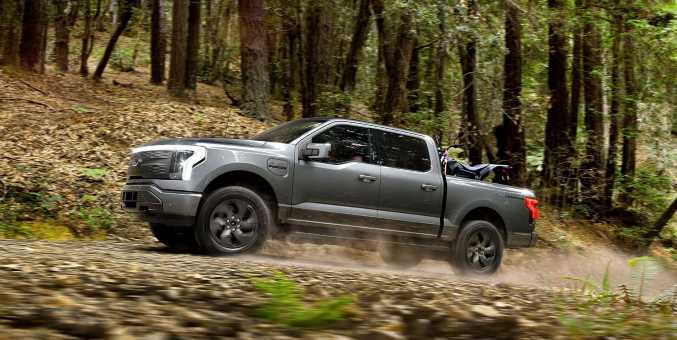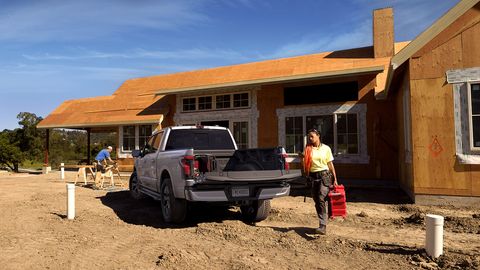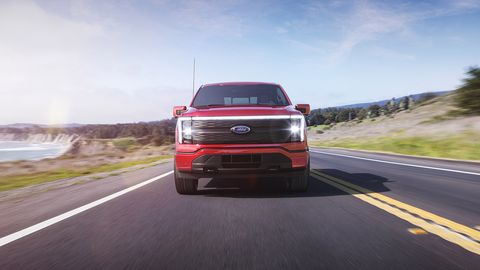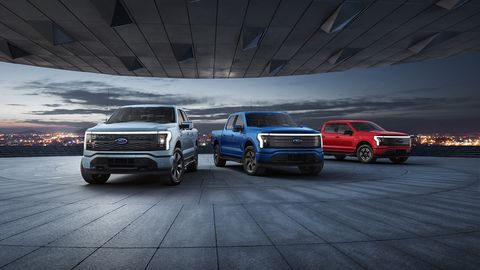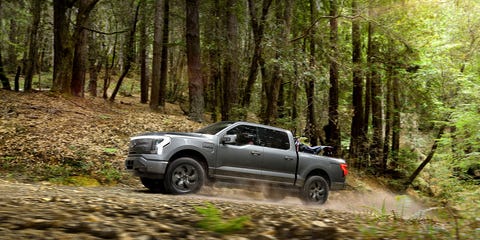
The Ford F-150 Lightning, revealed on Thursday night (May 20), is easily one of the most-important launches for Ford in this entire decade, and also one of the most important EV launches for any automaker. Making its global debut just months after the start of sales of the Mustang Mach-E, the 2022 F-150 Lightning wants to turn the Blue Oval’s best seller into the best-selling EV truck in America, and as we saw last night all the ingredients are there.
The F-150 Lightning is not meant to be an electric truck that happens to be useful in daily life, but to be a daily working truck that just happens to be electric. The F-150 Lightning is also meant to win over longtime Ford truck buyers with its versatility and impressive bag of tricks, even if they wouldn’t have otherwise thought about buying an EV, as well as those who’ve been waiting for a large and affordable electric SUV with the added versatility of a truck.
“We’re not here to make an electric truck for the few—Ford is committed to building one that solves real problems for real people,” said Kumar Galhotra, Ford president, Americas and International Markets Group. “F-150 Lightning delivers everything we’ve said electric vehicles can offer, plus the capability expected from a Built Ford Tough truck—not just near instant torque but powerful towing and hauling customers can depend on.”
Equipped with the standard-range battery, the F-150 Lightning produces 426 hp and 725 lb-ft of torque. Upgrade to the long-range battery, and you’ll get the bonus of having 563 hp and 725 lb-ft of torque to play with.
When it comes to towing and payload, the F-150 Lightning will tow 10,000 lbs, and will carry 2,000 lbs of cargo.
Staying true to the last Ford truck to use the name Lightning, the electric F-150 will also be able to launch itself from 0 to 60 mph in the mid-four second range, which President Joe Biden briefly quoted as being 4.3 or 4.4 seconds. Those aren’t quite the final figures, but judging from Ford’s statements, they’re close.
“Whether they’re hauling a bed full of firewood through snow or towing a trailer on a road trip, customers need to be able to rely on their truck’s performance,” said Linda Zhang, chief engineer, F-150 Lightning. “This all-electric truck has been engineered with dual in-board motors, which means it can take on rough terrain. Our team of engineers has run the same arduous test regimen our F-150 customers have learned to expect from Ford.”
The Ford F-150 will make the most of its electric nature, offering four power outlets in the frunk alone, and seven others elsewhere including in the bed in the cabin, for a total of 11. Needless to say, this will make it a popular truck for work tools with the Pro Power Onboard system. This system will also keep track of juice when power tools are being used and will notify the owner when the range falls below a certain point.
Perhaps more impressive than the ability to power tools on a worksite is the ability of the truck to power an entire home in the case of a power outage. The Ford Intelligent Backup Power option can provide 9.6 kilowatts of power to a home through its 80-amp Ford Charge Station Pro, which Ford can help install in a home garage. The system can automatically kick in when a loss of power occurs in a home, and then cut off the flow when power is restored.
“Whether sheltering during a storm or trying to stay safe in a heat wave, customers can now use their truck to give themselves power when they need it most,” said Ryan O’Gorman, electric vehicle manager, Strategic Partnerships. “F-150 Lightning is built for seamless transitions between charging your vehicle and powering your house when needed—and Ford is the first in the U.S. to offer this capability on an electric truck.”
The standard-range version of the F-150 Lightning is estimated to offer a range of 230 miles, while the extended-range flavor is slated to offer 300 miles—just a bit less than the Mustang Mach-E’s top range. These are EPA-range targets by the manufacturer, so the official EPA figures should be available in a few months, closer to the first F-150 Lightning deliveries next spring. So they could still change a bit.
The standard range will make the base truck an easy decision for those who use it to commute around town or use it in a pretty defined geographic area as a work truck, while the extended-range version will be aimed at customers who want the flexibility to take longer trips from time to time. The base range should also make it attractive to fleet buyers who use the truck in a certain area and can charge them overnight all in once place.
When it comes to charging, Ford says that using a 150-kW DC fast charger the Lightning can get enough juice in 10 minutes to add 54 miles of range, while going from 15% state of charge to 80% can be done in just 41 minutes with the same charger.
For charging on the go, the Lightning will feature FordPass Power My Trip, automatically identifying charging stations along a route, while the Intelligent Range function calculates range while taking into account factors such as payload, weather, traffic, and towing weight.
“Cloud-connected navigation on SYNC 4 also identifies public charging locations and prompts owners to charge at convenient points on each drive,” Ford adds.
True to the goal of offering an EV truck for everyone, the MSRP of the 230-mile standard-range F-150 Lightning will be just $39,974, prior to any federal or local incentives and prior to the destination charge, which will be announced later.
The mid-series XLT model is the only other version whose price has been published to date, and it will start at $52,974, once again prior to the addition of the destination charge, and before any federal and local discounts.
A total of four trim lines will be offered in addition to two battery options, with the extended-range battery being standard on the range-topping Platinum model, which is yet to receive an MSRP.
However, there is one other item to note about the $39,974 base price. Since all F-150 Lightnings will feature a crew cab, after the application of the $7,500 federal tax incentive the Lightning comes in below the price of the comparable gas-engined F-150, which is the short bed version of the F-150 XL SuperCrew 4WD. So at the end of the day, the base version of the EV truck with 230 miles on tap will end up costing buyers less than the gas-engined version of the same body style with AWD. And it will also deliver far more than the 260 hp and 265 lb-ft of torque of the comparable gasoline version, which features a 3.3-liter V6, with nearly triple the torque of the gas model to be found in the Lightning. “Triple the torque” is not something we get to say very often when comparing basic pickup trucks.
The truck will enter production in spring 2022, so we should know more details, including the official EPA range, in the coming months.
Source: Read Full Article
